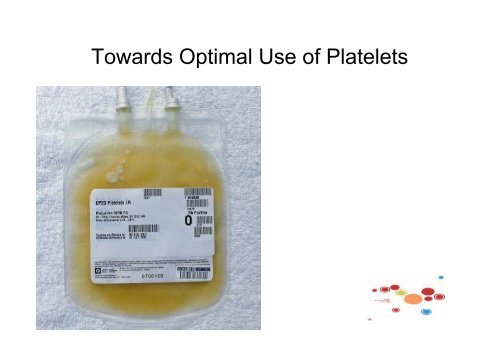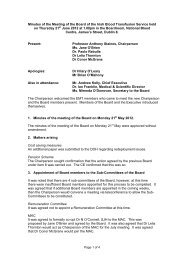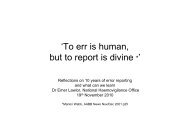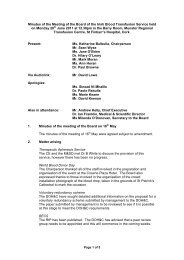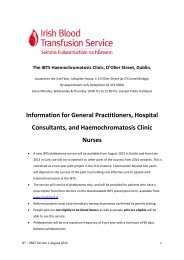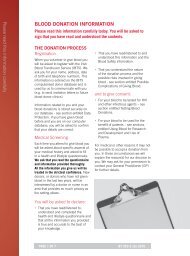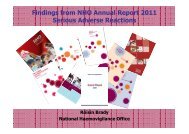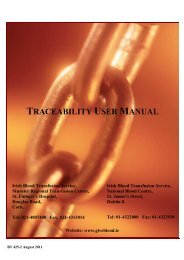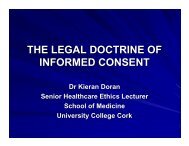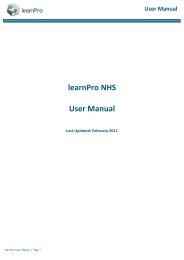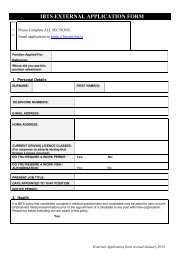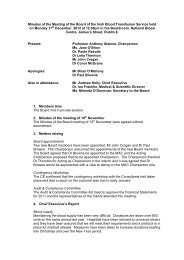Towards Optimal Use of Platelets - Irish Blood Transfusion Service
Towards Optimal Use of Platelets - Irish Blood Transfusion Service
Towards Optimal Use of Platelets - Irish Blood Transfusion Service
Create successful ePaper yourself
Turn your PDF publications into a flip-book with our unique Google optimized e-Paper software.
<strong>Towards</strong> <strong>Optimal</strong> <strong>Use</strong> <strong>of</strong> <strong>Platelets</strong>
<strong>Platelets</strong> issued 2000-200825,00020,000Units issued15,00010,0005,00002000 2001 2002 2003 2004 2005 2006 2007 2008Apheresis Pooled Total
OBJECTIVES• Fate <strong>of</strong> platelet components issued• Reasons for increasing demand• Consultant opinion <strong>of</strong> anticipated future needs• Local policies &/or guidelines & compliance• Need for agreed national guidelines for plateletuse
METHODOLOGY• Qualitative: Structured interviews basedon pre posted questionnaire• Quantitative: Retrospective analysis <strong>of</strong>national sample <strong>of</strong> consecutive platelettransfusions
CATEGORISATION OF USERHOSPITALS(study period 1/1/07-30/6/08)Category Hospitals (n) Total 61•
STUDY RESULTS VALID• 93.5% consultants at 41/43hospitals interviewedRange <strong>of</strong> clinical services• 40/41 hospitals participatedin analysis 1,200 platelettransfusions (95% RR)403530• Selection bias eliminated byprovision <strong>of</strong> identifyingdetails <strong>of</strong> relevantcomponents• Hospitals representative <strong>of</strong>population servedn u m b e r2520151050Haem SC alloSCautoOncGen Cardiacsurg surgA/E ICU GenmedObs NeonatPaeds
KEY QUALITATIVE FINDINGS•Unaware <strong>of</strong> usage/wastage - Audit at only 13hospitals•9 hospitals had no policy/guideline as recommended•Lack <strong>of</strong> compliance with recommended dose &indication•Consultants gave clear mandate for nationalguidelines•Consensus developed by haematologists +other userrepresentation
PROJECTION OF FUTURE NEED• Aware <strong>of</strong> increased demand (86%)• Demand not increasing at their hosp(s) (14%)• Demand will continue to increase (53%) stabilise(40%) reduce (7%)• <strong>Use</strong> at the highest user hospital expected tocontinue to increase (15% p.a.)
REPORTED REASONS FORINCREASING DEMANDIncreasing clinical activity• Haemato-oncology• SCT (PBSC allografts + ATG)• Cardiac/other surgery• Trauma• Obstetrics• Neonatology• Anti-platelet therapyOver ordering
REMAINING AREAS OFUNCERTAINTY• Reported areas <strong>of</strong> uncertainty in commonsituations (62%)• Most common (27%) associated with antiplatelettherapy (Quantitative 6% use)• ATG therapy• Prophylaxis chronic haemato-oncology (MDS)• Tunnelled central line insertion• Endoscopy
KEY QUANTITATIVE FINDINGS• Details <strong>of</strong> 1199 platelet components sent to 41 hospitals• RR 95% (39/41) hospitals• Details <strong>of</strong> 1159 components provided• 94% transfused to 423 recipients• 6% not transfused• 5% outdated at hospital• 1% cancelled before shipping from NBC (9), re-routedhosp (3) returned unusable (1)
CLINICAL USE OF PLATELETTRANSFUSIONReason documented (>90%)QualitativeQuantitative• Prophylaxis @71%• Control bleeding @29%hospitals• Prophylaxis 67%• Control bleeding 32%• Additional risks factors41%– most cm fever/sepsis
CLINICAL AREA WHERE PLATELETSMOST OFTEN TRANSFUSEDAnaesthetists (bleeding cardiac), Haematologists & oncologists(prophylaxis) highest usersQualitative• Haematology (exceeds allother use)• Oncology• ICU• Cardiac• General surgeryQuantitative• Haematology (33%)• ICU (13%)• Oncology (12%)• General medicine* (10%)• Neonatology* (8%)• Cardiac surgery (7%)• General surgery (7%)*Under estimated in qualitative survey
Clinical unitGen medicine10%A/E1%DCU2%Paeds1%Other0%Neonates8%Haematology32%ICU13%Gen surgery8% Obstetrics3%Cardiac Surgery7%Oncology13%BMT2%
PROPHYLACTIC PLATELETTRANSFUSIONQualitative• Chemotherapy inducedthrombocytopenia• Sepsis associatedthrombocytopenia• Invasive procedures• BMF syndromes• Massive traumaQuantitativePlus• General medicalconditions• Neonatology• Correct effect <strong>of</strong> antiplatelettherapy (6%)• Not massive trauma
631 COMPONENTS (PROPHYLAXIS)Pre transfusion platelet count (96%)• median 17 x10 9 /l mode 10 x10 9 /l range 1-625 x10 9 /l• 5% (32) components to recipients with normal plateletcounts (>150x10 9 /l)
THERAPEUTIC PLATELETTRANSFUSION TO CONTROL BLEEDINGTrigger platelet count mode 50x10 9 /l range 20-100x10 9 /l (except cardiac)Qualitative• Sepsis-associatedthrombocytopenia• Massive trauma• Obstetrics• Non-cardiac surgery• Chemotherapy-inducedthrombocytopeniaQuantitative• 27% Frank bleedingthrombocytopenic patients (mostcm GIT)• 9% surgical bleeding (62% cardiac)• 6% normal platelet count (45%cardiac, 15% other surgery, 13%GIT)• None sepsis-associatedthrombocytopenia (us prophylactic)• Few massive trauma, obstetrics,chemotherapy-induced t’penia
DOSE & INDICATIONS FOR > 1 DOSEQualitative• 93% routine dose = 1 pool> 1 pool• Massive haemorrhage (cardiacsurgery, massive trauma, DIC,sepsis• Pre invasive procedures +inadequate incremental countafter 1• Routine prophylaxis haematology(4%)• Drift towards routine use 2 dosesprophylaxis haematology/otherpatientsQuantitative• 24% >1 dose• Not all bleeding• Most <strong>of</strong>ten prophylaxishaem.(20%) /oncology (15%)patients• Cardiac surgery 21%• ICU 15%• General medicine* 12%• Non cardiac surgery* 10%• Obstetrics 4%• Neonatology* 3%• Anti platelet therapy*Not reported in the qualitative survey
AUDIT & WASTAGE OF PLATELET COMPONENTSQualitative• Aware <strong>of</strong> wastage at 80% hospitals dt outdating, over ordering & inappropriateTx• 45% consultants had audited platelet usage at 13 (32%) hospitals• Documented evidence at 10 hospitals. Reported range 1 dose• Consultants overestimated wastage dt change in clinical condition <strong>of</strong> patient &underestimated wastage dt over-ordering & inappropriate transfusion
OVERORDERINGReported delivery times:38% 1hr 31% 2 hrs 28% 4 hrs 3% 6 hoursDisadvantages patients Anxiety Over ordering Dissatisfied hospital staff (50%)Delivery time for emergency orders108number64206 hr
OVER ORDERINGInability to hold stock platelets (93%) underliesover ordering & consequent wastageProposed solutions• Holding ‘stock’ platelets at individual hospitals• Regional holding Centres/’hubs’• Redistribution from hospitals within regions• <strong>Use</strong> <strong>of</strong> ABO non identical platelets
CONCLUSIONS• Majority <strong>of</strong> platelets issued transfused some unnecessarily so• Significant wastage at almost all hospitals dt outdating, overordering & inappropriate use. Estimated cost, outdating alone,€1,108,361 p.a.• Increasing demand dt increased clinical activity & inappropriate use(higher platelet triggers & >1 dose)• No guidelines at many hospitals. Variable standard. Reported poorcompliance with dose confirmed• Consensus need for national guidelines
RECOMMENDATIONS• Regular IBTS & in- hospital audit to monitor & optimiseplatelet use esp. orders >1 dose to ID reasons, activefiltering <strong>of</strong> such requests & regular feedback to increaseawareness & reduce inappropriate over-ordering• IBTS should ask all user hospitals to monitor & provideinformation on platelet components not transfused SinceJan 2011 – 5% nationally• IBTS should lead development <strong>of</strong> national guidelines forplatelet transfusion with representation <strong>of</strong> all users Inprogress
RECOMMENDATIONS• Platelet Tx in cardiac surgery should be compared vs. internationalnorms• Better use <strong>of</strong> available CMV neg platelets by ensuring used forpatients who truly need them. Blanket policies <strong>of</strong> universaladministration <strong>of</strong> CMV neg platelets should be modified to optimiseuse <strong>of</strong> CMV neg platelets• CMV status <strong>of</strong> platelet components not issued from IBTS should beanalysed to determine if CMV positive componentsdisproportionately represented3 hospitals take 37% <strong>of</strong> all platelets issued as CMV neg onlyassuming 75%:25% CMV neg/pos pop IBTS have to supply c. 85%CMV neg
RECOMMENDATIONS<strong>Platelets</strong> should be available within 30-60 minsfor emergency use. Consideration given toholding stock platelets at individual hosps orregional hubs holding stock for redistribution inemergencyEndorsed by IHS - should be available inhospitals with EDs &/or obstetric unitNot yet implemented
IBTS Annual Report 2010
ApheresisPooledTotal30000Projected <strong>Platelets</strong> issued to yr end 20112500020000Unitsissued1500010000500002000 2001 2002 2003 2004 2005 2006 2007 2008 2009 2010 2011 p2011
SINCE 2008 ?STABILISING• Total doses issued apheresis pooled cost• 2008 24415 13629 (56%) 10786 €20,168,520.88• 2009 26474 17271 (65%) 9203 €21,691,925• 2010 24557 18967 (77%) 5590 €20,182,531• 2011* 18527 14511 (78%) 4016 €15,156,613*(9 mths)Unnecessary donor exposure, squandering goodwill & donor commitmentDonor risk vs. Patient need
<strong>Use</strong> is not optimalCONCLUSION• Implementation & Adherence to National Guidelines• Proactive IBTS & Hospital audit & monitoring <strong>of</strong> demand- indication & dose• Improved communication• Timely availability <strong>of</strong> platelets for emergency use<strong>Use</strong> could be optimised
ACKNOWLEDGEMENTS• Consultant haematologists• Haemovigilance <strong>of</strong>ficers• Hospital blood bank staff• IBTS staff


